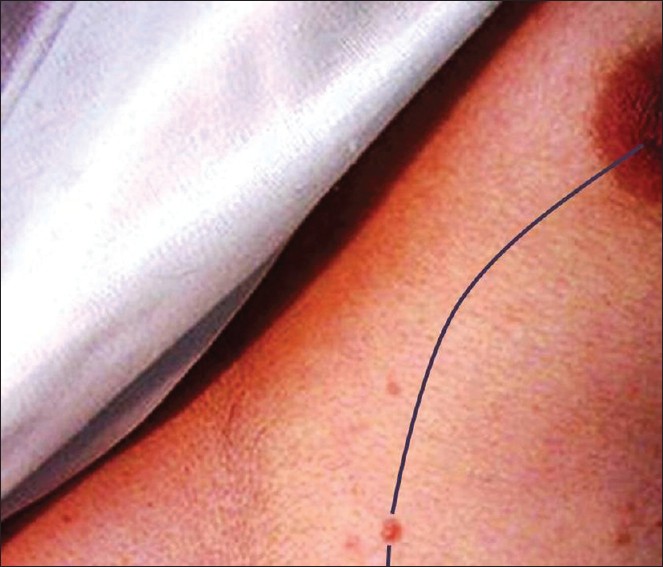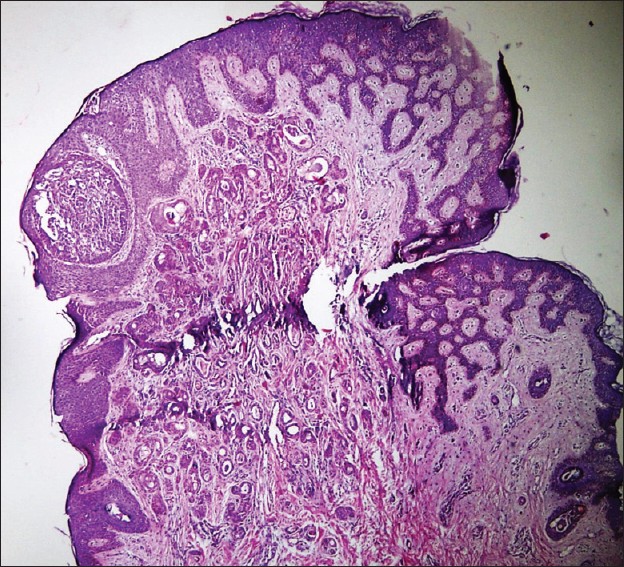Translate this page into:
Syringomatous adenoma occurring within a supernumerary nipple
Correspondence Address:
Saffar Hana
Razi Hospital, Vahdate eslami Sq. Tehran
Iran
| How to cite this article: Azita N, Hana S. Syringomatous adenoma occurring within a supernumerary nipple. Indian J Dermatol Venereol Leprol 2011;77:730 |
Sir,
The presence of accessory breast tissue such as extra nipple (polythelia) is relatively common with high incidence of being misdiagnosed in clinical medicine. This accessory tissue has the ability to undergo the pathological changes that are the characteristics of the normal breast tissue. [1] Syringomatous adenoma of the nipple (SAN) is a rare, benign, locally invasive tumor with recurrence potential, showing sweat duct differentiation in microscopic examinations. [2]
We reported an 11-year-old female with syringomatous adenoma of the supernumerary nipple and emphasized on the significance of proper diagnosis in order to distinguish these benign lesions from primary or metastatic lesions of the breast origin or infiltrative tumors of the skin.
An 11-year-old female patient presented with a small papule on the chest 1 year ago [Figure - 1]. The lesion was located along the embryonic mammary ridge giving the impression of a supernumerary nipple. The lesion was asymptomatic and only of the cosmetic concern to the patient. The microscopic examination showed a tumor superimposed on a supernumerary nipple composed of ducts and tubules lined with double-layered epithelial cells. The lining cells were small, cuboidal, with central nuclei and eosinophilic nucleoli. Ducts showed a comma or tadpole-shaped appearance reminiscent of syringoma [Figure - 2]. Some ducts were dilated with squamous metaplasia. One of these cysts was connected to the overlying epidermis [Figure - 3]. No local recurrence has been reported 18 months after original biopsy.
 |
| Figure 1: Small papule on the chest along the course of milk line (purple line) |
 |
| Figure 2: Low power image of syringomatous nipple adenoma; note the irregularity and infiltrative pattern of the neoplasm (H and E, ×10) |
 |
| Figure 3: A focused area of the syringomatous adenoma found in Figure 2. Note the irregular duct-like structures reminiscent of syringoma. Also note the ducts with squamous metaplasia (H and E, ×10) |
Supernumerary breast tissue is relatively common finding with a variably reported incidence rate ranging from 0.22% to 6% of the general population. Most lesions develop along the embryonic mammary ridge that extends from the axilla to the groin. [1]
In 1915, Kajava [3] classified the expression of accessory breast tissue into eight categories based on the presence or absence of the nipple, areola, and glandular tissue. The most common type of accessory breast tissue is polythelia which is defined as a supernumerary nipple without areola or glandular structures. [1],[3]
SAN was firstly described by Rosen [4] in 1983. From the clinical standpoint, SAN is a solitary, unilateral nipple tumor that may be tender and painful or may cause nipple discharge or inversion. On the microscopic examination SAN is a tumor of the adnexal origin, consists of clusters of small ducts lined by a double layer of flattened epithelial cells that occasionally show comma-shaped extensions. [4]
It is important to distinguish this rare lesion from other benign common histopathologic similarities including florid papillomatosis of the nipple, intraductal papillomas with squamous metaplasia and tubular adenoma. Low-grade mammary malignancies including tubular carcinoma or low-grade adenosquamous carcinoma and primary skin tumor such as microcystic adnexal carcinoma should be differentiated from syringomatous adenoma. [5]
In particular, cases such as our case both primary breast lesions and cutaneous neoplasms should be considered in the differential diagnosis. The clinical history and presence of benign breast structures in supernumerary breast tissue are helpful diagnostic features.
According to both clinical examinations and pathological studies, we diagnosed our case as syringomatous adenoma of the nipple. The presence of popular lesion along embryonic mammary ridge, showing acanthosis and basal layer pigmentation in the microscopic examination were highly suggestive for the lesion to be supernumerary nipple and characteristic histopathological features of syringomatous adenoma were evident as previously described. In contrast to case of syringomatous adenoma in the supernumerary breast [5] that showed normal breast ducto tubular structures intimate to neoplastic lesion, no evidence of glandular components or normal breast tissue was identified in our patient.
In conclusion, we believe that a clear understanding of the spectrum of breast lesions with syringomatous features and its possible occurrence in supernumerary breast tissue will be helpful in distinguishing these benign, locally invasive lesions from primary or metastatic lesions of the breast origin or the infiltrative tumor of the skin.
| 1. |
Loukas M, Clarke P, Tubbs RS. Accessory breasts: A historical and current perspective. Am Surg 2007;73:525-8.
[Google Scholar]
|
| 2. |
OdashiroM, Lima MG, Miiji LN, Odashiro DN, Carvalho GV, Prates-Campos JC, et al. Infiltrating syringomatous adenoma of the nipple. Breast J 2009;15:414-6.
[Google Scholar]
|
| 3. |
Kajava Y. The proportions of supernumerary nipples in the finish population. Duodecim 1915;1:143-70.
[Google Scholar]
|
| 4. |
Rosen PP. Syringomatous adenoma of the nipple. Am J Surg Pathol 1983;7:739-45.
[Google Scholar]
|
| 5. |
Page RN, Dittrich L, King R, Boulos F, Page DL. Syringomatous adenoma of the nipple occurring within a supernumerary breast: A case report. J Cutan Pathol 2009;36:1206-9.
[Google Scholar]
|
Fulltext Views
2,565
PDF downloads
2,474





